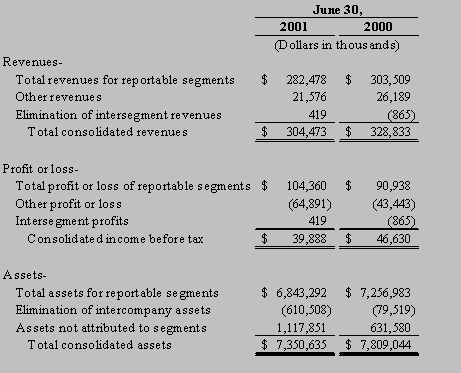SANTANDER BANCORP
NOTES TO CONSOLIDATED FINANCIAL STATEMENTS (UNAUDITED)
JUNE 30, 2001 AND 2000
Summary of Significant Accounting Policies:
Basis of Presentation
Santander Bancorp (the Corporation) was reorganized on May 2nd, 2000 under the laws of the Commonwealth of Puerto Rico to serve as the bank holding company for Banco Santander Puerto Rico and Subsidiary (the "Bank") and other entities as management deemed appropriate. As a result of this reorganization each of the Bank´s outstanding shares of common stock was converted into one share of common stock of the new bank holding company. This reorganization was carried out pursuant to an Agreement and Plan of Merger by and between the Corporation and the Bank. Santander BanCorp is subject to the Federal Bank Holding Company Act and to the regulations, supervision, and examination of the Federal Reserve Board. The reorganization was treated as a tax free reorganization and the exchange by the Bank´s shareholders of their shares of the Bank´s common stock for shares of Santander BanCorp common stock constituted a tax free exchange for purposes of Puerto Rico income tax laws.
On September 26, 2000 the Corporation acquired 100% of the common stock of Inversiones y Desarrollos del Caribe, Inc. (INDECA) now doing business as Santander Insurance Agency, for the purpose of establishing an insurance agency. Santander Insurance Agency was approved by the Commissioner of Insurance of Puerto Rico to operate as an insurance and general agent, effective October 10, 2000.
The accounting and reporting policies of Santander BanCorp and its subsidiaries conform with generally accepted accounting principles and banking industry practices in the United States. The reorganizations were recorded at historical cost in a manner similar to a pooling of interests. Accordingly, at acquisition date, the Corporation recorded the assets acquired and liabilities assumed at book value and consolidated balance sheets, statements of income, changes in stockholders´ equity and comprehensive income and cash flows were presented as if the entities had been merged at the beginning of the year. All significant intercompany balances and transactions were eliminated.
In preparing the consolidated financial statements, management is required to make estimates and assumptions that affect the amounts reported in the consolidated financial statements and accompanying notes. Actual results could differ from those estimates.
The interim consolidated financial statements included herein are unaudited, but reflect all adjustments, which, in the opinion of management, are necessary for a fair presentation of the consolidated financial condition, results of operations and cash flows for the interim periods presented. Adjustments included herein are of a normal recurring nature and include appropriate estimated provisions. The interim consolidated financial statements as of June 30, 2001 included herein have been prepared on a consistent basis with the year end audited financial statements as of December 31, 2000.
Principles of Consolidation
The consolidated financial statements include the accounts of the Corporation, Santander Insurance Agency, the Bank and the Bank´s wholly owned subsidiary, Santander Mortgage Corporation. All significant intercompany balances and transactions have been eliminated in consolidation.
Derivative Financial Instruments
The Corporation uses derivative financial instruments mostly as hedges of interest rate risk and to secure future cash flows. Until December 31, 2000, gains and losses on these contracts were deferred and were reflected in income when the contracts were settled. Effective January 1, 2001, the Corporation accounts for its derivative instruments following the provisions of Statement of Accounting Standards No. 133 (SFAS No. 133), "Accounting for Derivative Instruments and Hedging Activities", as amended. The Corporation engages on a limited basis in derivative financial instruments for trading purposes.
Earnings Per Common Share
Basic and diluted earnings per common share are computed by dividing net income attributable to common stock, by the weighted average number of common shares outstanding during the period. The Corporation´s average number of common shares outstanding used in the computation of earnings per common share was 39,912,470 and 42,285,770 at June 30, 2001 and 2000, respectively. Basic and diluted earnings per share are the same since no stock options or other stock equivalents were outstanding during the periods ended June 30, 2001 and 2000.
Accounting for Derivative Instruments and Hedging Activities
During 1998, the Financial Accounting Standards Board (the Board) issued Statement of Financial Accounting Standards No. 133 (SFAS No. 133), "Accounting for Derivative Instruments and Hedging Activities". During 1999, the Board issued Statement of Financial Accounting Standards No. 137 (SFAS No. 137), "Accounting for Derivative Instruments and Hedging Activities Deferral of the Effective Date of FASB Statement No. 133", which delays the effective date of SFAS No. 133 for one year. In addition, during 2000 the Board issued Statement of Financial Accounting Standards No. 138 (SFAS No. 138) "Accounting for Certain Derivative Instruments and Certain Hedging Activities an Amendment of FASB Statement No. 133", which addressed a limited number of issues causing implementation difficulties for numerous entities that apply SFAS No. 133. SFAS No. 133, as amended establishes accounting and reporting standards for derivative instruments and hedging activities. It requires that an entity recognize all deriva tives as either assets or liabilities in the statement of financial position and measure those instruments at fair value. If certain conditions are met, a derivative may be specifically designated as (a) a hedge of the exposure to changes in fair value of a recognized asset or liability or an unrecognized firm commitment, (b) a hedge of the exposure to variable cash flows of a forecasted transaction, or (c) a hedge of the foreign currency exposure of a net investment in a foreign operation, an unrecognized firm commitment, an available for sale security, or a foreign currency denominated forecasted transaction. The accounting for changes in the fair value of a derivative depends on the intended use of the derivative and the resulting designation. SFAS No. 133, as amended by SFAS No. 137 and SFAS No. 138, is effective for all fiscal quarters of fiscal years beginning after June 15, 2000 and should not be applied retroactively to financial statements of prior periods. The Corporation applied SFAS No. 133, as a mended, on January 1, 2001. The transition adjustment amounted to a loss of approximately $8,246,000 net of the effect of the related tax benefit of approximately $5,272,000 reported as a cumulative type adjustment in the statement of income and a loss of approximately $1,507,000 reported net of the effect of the related tax benefit of approximately $964,000 in other comprehensive income. Management expects that by the end of 2001, the net effect of the application of SFAS No. 133 on the Corporation´s consolidated financial position and results of operations will be immaterial in amount.
Other Accounting Pronouncements
The Financial Accounting Standards Board issued Statement of Financial Accounting Standards No. 142 (SFAS No. 142), "Goodwill and Other Intangible Assets" during June 2001. This statement establishes financial accounting and reporting standards for intangible assets acquired individually or with a group of other assets at acquisition, as well as financial accounting and reporting for goodwill and other intangible assets subsequent to their acquisition. SFAS No. 142 establishes that intangible assets and goodwill are initially recorded at fair value. Goodwill and certain intangible assets will cease to be amortized. Intangible assets and goodwill must be assessed for impairment at least annually and any impairment in value shall be recognized in current operations. This statement is effective for all fiscal years beginning after December 15, 2001 and retroactive application is not permitted. Goodwill and other intangible assets acquired after June 30, 2001 are subject to the provisions of SFAS No. 142 even if the statement has not been adopted in its entirety. The Corporation is currently in the process of implementing SFAS No. 142 and has not yet determined the impact on its consolidated financial statements.
2. Investment Securities Available for Sale:
Investment securities available for sale and related contractual maturities:

Contractual maturities on certain securities, including mortgage backed securities could differ from actual maturities since certain issuers have the right to call or prepay these securities.
The weighted average yield on investment securities available for sale is based on amortized cost; therefore, it does not give effect to changes in fair value.
3. Investment Securities Held to Maturity:
Investment securities and related contractual maturities:
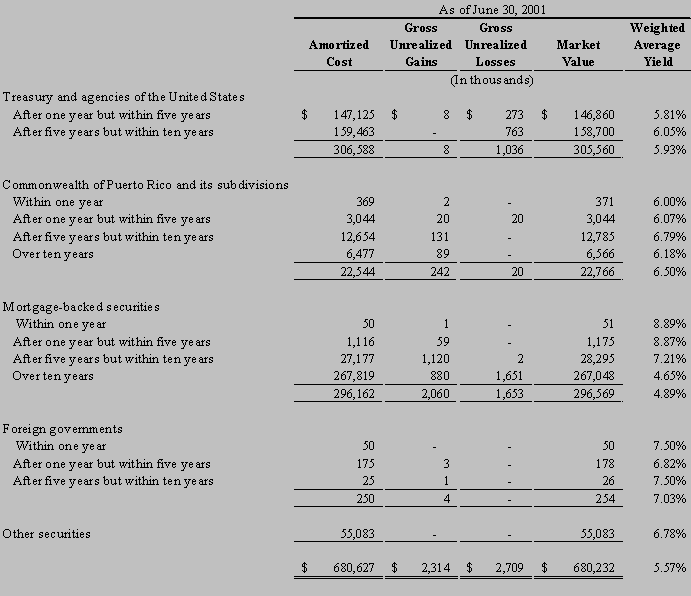

Contractual maturities on certain securities, including mortgage backed securities could differ from actual maturities since some issuers have the right to call or prepay these securities.
The weighted average yield on investment securities is based on amortized cost; therefore, it does not give effect to changes in fair value.
4. Loans
The Corporation´s loan portfolio at June 30, 2001 and December 31, 2000 consists of the following:
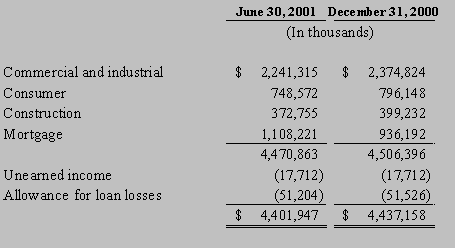
5. Allowance for Loan Losses:
Changes in the allowance for loan losses are summarized as follows:
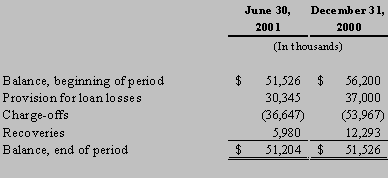
6. Other Assets:
Other assets consist of the following:
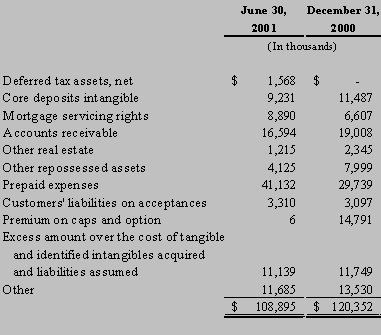
7. Short Term Borrowings:
Following are summaries of short term borrowings for the periods indicated, in thousands:

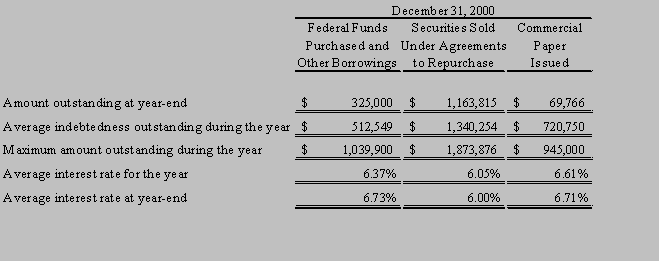
Federal funds purchased and other borrowings, repurchase agreements and commercial paper mature as follows:
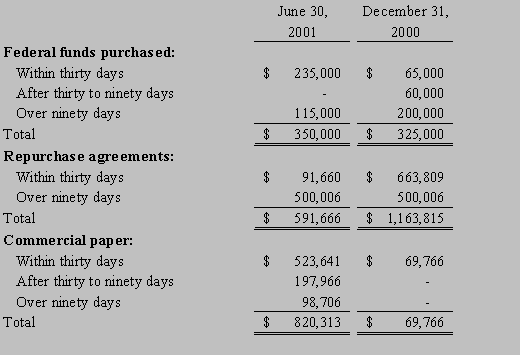
The following securities were sold under agreements to repurchase:


8. Stockholders´ Equity:
On May 2nd, 2000, the Bank underwent a corporate reorganization wherein Santander BanCorp, a bank holding company was incorporated. As a result, shareholders of Banco Santander Puerto Rico became shareholders of Santander BanCorp and Banco Santander Puerto Rico became a wholly owned subsidiary of Santander BanCorp in a tax free exchange for purposes of Puerto Rico income tax laws.
On September 26, 2000 the Corporation acquired 100% of the common stock of Inversiones y Desarrollos del Caribe, Inc. (INDECA) now doing business as Santander Insurance Agency, for the purpose of establishing an insurance agency. Santander Insurance Agency was approved by the Commissioner of Insurance of Puerto Rico to operate as an Insurance and General Agent, effective October 10, 2000.
On January 11, 2000, the Board of Directors of Banco Santander Puerto Rico declared a 10% stock dividend on common stock to shareholders of record as of January 31, 2000. The common stock dividend was distributed on February 22, 2000. Cash was paid in lieu of fractional shares. The earnings per share computations for all prior periods presented in the accompanying consolidated financial statements have been restated to reflect the stock dividend.
The Corporation adopted and implemented a Stock Repurchase Program in May 2000. Under the Stock Repurchase Program the Corporation acquired 3% of its outstanding common shares. On December 9, 2000, the Corporation started its second Stock Repurchase Program, under which it plans to acquire 3% of its outstanding common shares. During June 2001, the Corporation started a third Stock Repurchase Program under which it plans to acquire 3% of its outstanding common shares. As of June 30, 2001, 2,572,400 shares amounting to approximately $43,062,000 had been repurchased under the plans.
The Corporation declared cash dividends of $0.11 per common share to all stockholders of record as of March 9, 2001, and $0.11 per common share to all stockholders of record as of June 8, 2001.
The Bank continues to pay dividends on preferred stock at the rate of 7% annually.
9. Derivative Financial Instruments:
The operations of the Corporation are subject to the risk of interest rate fluctuations to the extent that interest earning assets (including securities) and interest bearing liabilities mature or reprice at different times or in differing amounts. Risk management activities are aimed at optimizing net interest income, given levels of interest rate risk consistent with the Corporation´s business strategies. The Corporation has only limited involvement with derivative financial instruments and uses them mostly for hedging purposes.
Asset liability risk management activities are conducted in the context of the Corporation´s liability sensitivity to interest rate changes. This liability sensitivity arises due to interest bearing liabilities repricing more frequently than interest bearing assets. The opposite applies when rates are rising.
To achieve its risk management objectives, the Corporation uses a combination of derivative financial instruments, including interest rate swaps, caps, and options. The Corporation is exposed to credit losses in the event of nonperformance by counterparties in certain derivative instruments. However, based on periodic assessment of counterparties´ credit worthiness, the Corporation does not anticipate nonperformance by such counterparties.
As of June 30, 2001, the Corporation had the following derivative financial instruments outstanding:
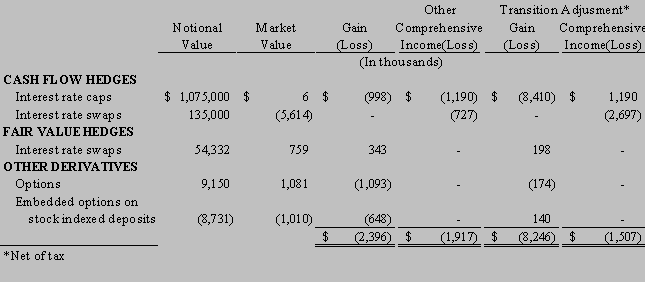
Interest rate caps are similar to option contracts that require the writer to pay the purchaser at specified future dates, the amount (if any) by which a specified market interest rate exceeds the fixed cap rate applied to a notional principal amount. The purchaser pays a premium for transferring the risk of unfavorable interest rate changes to the option writer. The Corporation´s principal objective in holding interest rate caps is the management of interest rate risk and to secure future cash flows, specifically to hedge the Corporation´s cost of funds, in the Commercial Paper Program and Repurchase Agreements, and to close the gap in a scenario of interest rates to the upside.
As of June 30, 2001, the Corporation had outstanding interest rate caps, with a notional value of $1,075,000,000, maturing through the year 2002. The caps are at a level of 5.75% and 6.50% against the one month Libor. The premium paid on these transactions was approximately $27,746,000 and was being amortized on a monthly basis over the life of the caps until December 31, 2000. On January 1, 2001, pursuant to the implementation of SFAS No. 133, the Corporation recognized a transition adjustment loss on the write off of the premium paid on caps of approximately $8,410,000 net of the effect of the related tax benefit of approximately $5,377,000 as a cumulative type adjustment in the consolidated statements of income. On that date, the Corporation also recorded a gain of approximately $1,190,000 net of the effect of the related tax cost of approximately $760,000 in other comprehensive income on the recognition of the intrinsic value of the caps derivative. As of June 30, 2001, the Corporation recognized a loss of approximately $1,190,000 net of the effect of the related tax benefit of approximately $760,000 in other comprehensive income due to the revaluation of that derivative. For the six months ended June 30, 2001, the Corporation recognized a loss of approximately $998,000 in other gains and losses due to hedge ineffectiveness of the caps.
Interest rate swaps involve the exchange of fixed and floating interest rate payments without an exchange of the underlying principal. Net interest settlements of interest rate swaps are recorded as an adjustment to interest income or interest expense of the hedged item.
The Corporation´s principal objective in holding interest rate swap agreements is the management of interest rate risk. The Corporation´s policy is that each swap contract be specifically tied to assets or liabilities with the objective of transforming the interest rate characteristic of the instrument. As of June 30, 2001, the Corporation had outstanding interest rate swap agreements, with a notional amount of approximately $189,332,000, maturing through the year 2014. The weighted average rate paid and received on these contracts is 6.02% and 5.05%, respectively. As of June 30, 2001, the Corporation had retail certificates of deposit amounting to approximately $50 million swapped to create a floating rate source of funds and a $4.3 million variable rate loan were fixed at a spread over U.S. Treasury securities. These swaps were designated as fair value hedges. The Corporation recognized a transition adjustment gain of approximately $198,000 net of the effect of the related tax cost of ap proximately $127,000, as a cumulative type adjustment on these swap agreements in the consolidated statements of income. For the six month period ended June 30, 2001, the Corporation recognized a gain of approximately $343,000 on fair value hedges due to hedge ineffectiveness included in other gains and losses on the consolidated statements of income.
The Corporation also swapped $35.0 million of floating rate medium term notes and $100.0 million of term funds at a fixed spread over U.S. Treasury securities. These swaps were designated as cash flow hedges. A transition adjustment loss of approximately $2,697,000 net of the effect of the related tax benefit of approximately $1,724,000 was recognized in other comprehensive income. For the six month period ended June 30, 2001, an additional loss of approximately $727,000 net of the related tax benefit of approximately $465,000 was recorded in other comprehensive income due to changes in the fair market value of the swaps.
The Corporation issues certificates of deposit and IRA accounts with returns linked to the Standard and Poor´s 500 index which constitutes an embedded derivative instrument that must be bifurcated from the host deposit and recognized on the balance sheet in accordance with SFAS No. 133. The Corporation enters into option agreements in order to manage the interest rate risk on these deposits however, these options have not been designated for hedge accounting, therefore gains and losses on the market value of both the embedded derivative instruments and the option contracts are marked to market through earnings and recorded in other gains and losses on the consolidated statements of income.
10. Regulatory Matters:
The Corporation is subject to various regulatory capital requirements administered by the federal banking agencies. Failure to meet minimum capital requirements can initiate certain mandatory and possibly additional discretionary actions by regulators that, if undertaken, could have a direct material effect on the Corporation´s consolidated financial statements. The regulations require the Corporation to meet specific capital guidelines that involve quantitative measures of the Corporation´s assets, liabilities, and certain off balance sheet items as calculated under regulatory accounting practices. The Corporation´s capital classification is also subject to qualitative judgements by the regulators about components, risk weightings, and other factors.
Quantitative measures established by regulation to ensure capital adequacy require the Corporation to maintain minimum amounts and ratios, as indicated below, of Total and Tier I capital (as defined) to risk weighted assets (as defined), and of Tier I capital (as defined) to average assets (as defined). In management´s opinion, the Corporation meets all capital adequacy requirements to which it is subject as of June 30, 2001.
As of June 30, 2001, the Corporation was well capitalized under the regulatory framework for prompt corrective action. To be categorized as well capitalized the Corporation must maintain a minimum total risk based, Tier I capital and Tier I leverage ratio as set forth in the following table. In management´s opinion, there are no conditions or events since that notification that would have changed the institution´s category.
At June 30, 2001, required and actual regulatory capital amounts and ratios follow:

At December 31, 2000, required and actual regulatory capital amounts and ratios follow:

11. Contingencies and Commitments:
Pursuant to the Purchase and Sale Agreement (the "Agreement") dated March 6, 1996 between Banco Santander, S.A. (BSSA) and Banco Central Hispanoamericano, S.A. (BCH), the Corporation´s Parent Company, BSSA, acquired 99.25% of the common stock of Banco Central Hispano Puerto Rico (BCHPR). Shortly, thereafter, the Corporation acquired substantially all the assets and assumed substantially all the liabilities of BCHPR. Under the Agreement and other related agreements, the Corporation is indemnified by BCH against any losses, damages or claims suffered by the Corporation or its subsidiaries resulting from the activities conducted by BCHPR in Puerto Rico prior to August 20, 1996, which were not adequately reflected in the December 31, 1995 audited financial statements and January 31, 1996 unaudited financial statements. This indemnity is limited in time to those claims filed before August 20, 1998, with the exception of tax and labor claims, which are only limited by the applicable statutes of li mitations corresponding to such claims. InApril 1999, BSSA and BCH merged their worldwide operations. The Parent as successor to BCH agreed to indemnify the Corporation under the same terms as the previous indemnity under the Agreement.
The Corporation is involved as plaintiff or defendant in a variety of routine litigation incidental to the normal course of business. Management believes, based on the opinion of legal counsel, that it has adequate defense or insurance protection with respect of such litigation and that any losses therefrom, whether or not insured, would not have a material adverse effect on the consolidated results of operations or consolidated financial position of the Corporation.
12. Segment Information:
Types of Products and Services
The Corporation has five reportable segments: BranchBased Commercial Banking, Corporate Banking, Consumer Banking, Mortgage Banking, and Investments. The insurance operation is another line of business in which the Corporation commenced its involvement during 2000. However, no separate disclosures are being provided on these operations, since the insurance agency is currently in a start up phase and had no significant operations during 2001. Through its Branch Based Commercial Banking, the Corporation provides a full range of financial products serving middle market customers and other market segments. This segment focuses on areas such as middle market, agriculture, small business, factor liens, public sector and international. Corporate banking is a centralized unit, providing credit services to large locally owned entities, subsidiaries of foreign companies and companies operating in specialized sectors. Through its branch network, the Corporation offers a wide variety of consumer banking servi ces and products, including personal loans, automobile loans, credit and debit cards and deposit accounts. The Corporation engages in mortgage banking through the Bank´s subsidiary, Santander Mortgage Corporation. Santander Mortgage Corporation´s business consists principally of the origination and acquisition of loans secured by residential mortgages. Through the activities of its Investment Department, the Corporation manages its assets and liabilities maximizing its net interest income, return on assets and return on equity while remaining within established parameters of interest rate and liquidity risks.
Measurement of Segment Profit or Loss and Segment Assets
The Corporation´s accounting policies for segments are the same as those described in the summary of significant accounting policies. Management evaluates segment performance based on segment profit or loss before income taxes. The Corporation accounts for inter segment sales and transfers as if the sales or transfers were to third parties, that is, at current market prices.
Management Policy in Identifying Reportable Segments
The Corporation´s reportable business segments are strategic business units that offer distinctive products and services that are marketed through different channels. These are managed separately because of their unique technology, marketing and distribution requirements.
The following presents financial information of reportable segments for the periods ended June 30, 2001 and 2000. None of the following items have been added or deducted in the determination of operating segment profits: general corporate expenses, income taxes and provision for loan losses. The "Other" column includes the items necessary to reconcile the identified segments to the reported consolidated amounts.
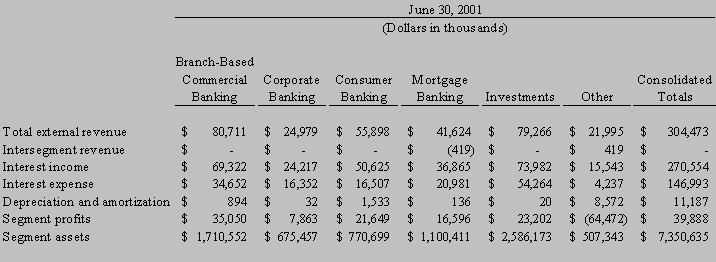

Reconciliation of Segment Information to Consolidated Amounts
Information for the Corporation´s reportable segments in relation to the consolidated totals follows:
